Evaluation of Thermal Comfort in Traditional Houses in a Tropical Climate
Abstract
1. Introduction
2. Climate
3. Traditional Context of Bushehr
4. Passive Design Solutions in Tabib’s and Nozari’s Houses
- (1)
- Yard: Yards have a close relation with the wind and is assumed to be a place for providing wind circulation. The central courtyard reduces air temperature at the internal spaces by replacing fresh and cool air from the outside. The courtyard, as a passive design strategy, creates indoor air velocity to the adjacent rooms by means of stack and cross ventilation.
- (2)
- Shenashir: This is a half-closed space located in the front of the closed space and protects the closed backspace from direct sunlight. On the other hand, due to the building’s shadow on the outer surface, the temperature of the chamber reduces. External and internal Shenashir are shown in Table 2 and Figure 7.
- (3)
- Openings: They play an important role in the hot-humid climate. The location of openings in a room is mostly related to the wind direction. In the architectural design of openings, it is important to determine the orientation of the openings in the building to provide appropriate light and air flow. In most of the cases, openings are exposed to the outside and orientated to the north and south.
- (4)
- Terrace: This is a non-enclosed space covered and located on each individual level of the building. A terrace is surrounded by and covered with wooden blinds and sun straw. Terraces of the houses are half open space that are exposed to air and are cooler than other parts of the building. In addition, terraces bring favorable winds into the spaces of the building itself. Terraces are shown in the plans in Table 2 and Figure 8.
- (5)
- Rooms: They are usually surrounded by the yard at different sides. The ratio of height to the width is not too large, normally 1:2 or 1:3. These ratios offer better ventilation in the yards as well as rooms in close proximity to the yard. The height of a room causes warm air to moved upward and reduces the room air temperature. In addition, building height is an element that provides wind pressure at the external surface building. As a result, a building can be naturally ventilated by the difference in pressure.
- (6)
- Single-layer rooms: Rooms have two effective side: yard and surrounding streets sides. They have openings on both sides to provide wind circulation. Because of the importance of airflow, each space should have a window for air pressure in the suction area as well as another outgoing path. Thus, it is better to have outdoor space with two fronts in relation to the airflow. In general, natural ventilation in the buildings has three passive effects that are outlined in Figure 9.
- (1)
- Stone: Coral reef rock with limestone is one of the basic materials in Bushehr. The stone is used in the foundation, walls, and in building facade because it has high resistance to moisture. These rocks are porous with very good thermal and acoustic insulation properties.
- (2)
- Mud mortar and plaster: Clay is beaten and mixed with hydrated lime and water and used as mortar for building structures in building foundations and walls. The mortar is used in places where moisture and water penetration directly affects the building.
- (3)
- Wood: Materials with low thermal conductivity like wood are used in hot-humid climates. The main problem is overheating and storing heat in this climate, which should not be transferred inside the building. For this reason, the best types of material is wood roofing. These materials can be used both for windows and doors. Wood releases heat slowly and transfers the gained heat smoothly. Thus, the wood surface remains relatively cool in the evening.
5. Methodology
5.1. Sensors and Data Logger
5.2. Experimental Test Conditions
6. Results and Discussion
7. Conclusions
- (1)
- The main factor in creating indoor thermal comfort in older buildings in hot-humid climates in summer is using natural ventilation. Wind-induced ventilation by the difference in pressure (cross ventilation) was the main reason for wind circulation inside the studied houses.
- (2)
- It is convenient to reduce temperature by using a light color on the exterior parts of the buildings, which contributes to the mitigation of indoor air temperature.
- (3)
- Using materials with low thermal conductivity, such as wood in the ceilings and windows in the buildings, improve thermal comfort.
- (4)
- Using local materials (coral stone and gypsum) in the external and internal wall of the building reduces indoor temperature and provides acceptable conditions for occupants.
- (5)
- Passive elements in the older architecture play an important role in providing thermal comfort. Based on a review of the literature and the quantitative results of this study, effective elements were identified. Using vertical and horizontal canopies, portico, and semi-open space, and external and interior Shenashir could significantly reduce indoor air temperature.
- (6)
- External Shenashir creates shadow and controls the air flow to the interior. Also, it enables maximum use of the wind flow and the sea breeze to reduce the humidity in the building. Its function is based on the difference in air pressure. As the air pressure on the surfaces of Shenashir is higher than the indoor air pressure, the wind circulates smoothly in the studied rooms.
- (7)
- The central courtyard is used in older houses during summer time. Based on the results, the temperature of the yard is lower than the ambient outdoor air temperature.
Author Contributions
Funding
Conflicts of Interest
References
- Moonen, P.; Defraeye, T.; Dorer, V.; Blocken, B.; Carmeliet, J. Urban Physics: Effect of the micro-climate on comfort, health and energy demand. Front. Archit. Res. 2012, 1, 197–228. [Google Scholar] [CrossRef]
- Vega-Azamar, R.E.; Glaus, M.; Hausler, R.; Oropeza-García, N.A.; Romero-López, R. An emergy analysis for urban environmental sustainability assessment, the Island of Montreal, Canada. Landsc. Urban Plan. 2013, 118, 18–28. [Google Scholar] [CrossRef]
- Chávez, J.R.G.; Melchor, F.F. Application of combined passive cooling and passive heating techniques to achieve thermal comfort in a hot dry climate. Energy Procedia. 2014, 57, 1669–1676. [Google Scholar] [CrossRef]
- Afshari, H. Design Fundamentals in the hot and humid climate of Iran: The case of Khoramshahr. Asian Cult. Hist. 2012, 4, 65. [Google Scholar] [CrossRef]
- Foruzanmehr, A. Summer-time thermal comfort in older earth dwellings in Yazd, Iran. Int. J. Sustain. Des. 2012, 2, 46. [Google Scholar] [CrossRef]
- Ranjbar, E.; Pourjafar, M.; Khaliji, K. Creative climatic design fits with the wind in Bushehr old. Bagh. Nazar. 2010, 7, 17–34. [Google Scholar]
- Nematchoua, M.K.; Tchinda, R.; Orosa, J.A. Thermal comfort and energy consumption in modern versus traditional buildings in Cameroon: A questionnaire-based statistical study. Appl. Energy 2014, 114, 687–699. [Google Scholar] [CrossRef]
- Dili, A.S.; Naseer, M.A.; Varghese, T.Z. Thermal comfort study of Kerala traditional residential buildings based on questionnaire survey among occupants of traditional and modern buildings. Energy Build. 2010, 42, 2139–2150. [Google Scholar] [CrossRef]
- Ramli, N.H. Re-adaptation of Malay House Thermal Comfort Design Elements into Modern Building Elements—Case Study of Selangor Traditional Malay House & Low Energy Building in Malaysia. Iran. J. Energy Environ. 2012, 3, 19–23. [Google Scholar] [CrossRef]
- Sarkar, A. Study of Climate Responsive Passive Design Features in Traditional Hill Architecture of Khyah Village in Hamirpur, Himachal Pradesh, India for Indoor Thermal Comfort. J. Inst. Eng. Ser. A 2013, 94, 59–72. [Google Scholar] [CrossRef]
- Wang, L.J.; Liu, J.P.; Liu, Y.F.; Wang, Y.Y.; Chen, J. Study on Thermal Environment of Traditional Architecture in Tropic Climate. Adv. Mater. Res. 2011, 243–249, 6857–6861. [Google Scholar] [CrossRef]
- Labaki, L.C.; Kowaltowski, D.C.C.K. Bioclimatic and older design in urban settlements of Brazil. Build. Environ. 1998, 33, 63–77. [Google Scholar] [CrossRef]
- Toe, D.H.C.; Kubota, T. Comparative assessment of older passive cooling techniques for improving indoor thermal comfort of modern terraced houses in hot–humid climate of Malaysia. Sol. Energy 2015, 114, 229–258. [Google Scholar] [CrossRef]
- Borong, L.; Gang, T.; Peng, W.; Ling, S.; Yingxin, Z.; Guangkui, Z. Study on the thermal performance of the Chinese traditional older dwellings in Summer. Energy Build. 2004, 36, 73–79. [Google Scholar] [CrossRef]
- Ryu, Y.; Kim, S.; Lee, D. The influence of wind flows on thermal comfort in the Daechung of a traditional Korean house. Build. Environ. 2009, 44, 18–26. [Google Scholar] [CrossRef]
- Al-Hinai, H.; Batty, W.J.; Probert, S.D. Older architecture of Oman: Features that enhance thermal comfort achieved within buildings. Appl. Energy 1993, 44, 233–258. [Google Scholar] [CrossRef]
- Saadatian, O.; Haw, L.C.; Sopian, K.; Sulaiman, M.Y. Review of windcatcher technologies. Renew. Sustain. Energy Rev. 2012, 16, 1477–1495. [Google Scholar] [CrossRef]
- Singh, M.K.; Mahapatra, S.; Atreya, S.K. Bioclimatism and older architecture of north-east India. Build. Environ. 2009, 44, 878–888. [Google Scholar] [CrossRef]
- Singh, M.K.; Mahapatra, S.; Atreya, S.K. Thermal performance study and evaluation of comfort temperatures in older buildings of North-East India. Build. Environ. 2010, 45, 320–329. [Google Scholar] [CrossRef]
- Fernandes, J.; Pimenta, C.; Mateus, R.; Silva, S.M.; Bragança, L. Contribution of portuguese older building strategies to indoor thermal comfort and occupants’ perception. Buildings 2015, 5, 1242–1264. [Google Scholar] [CrossRef]
- Fernandes, J.; Mateus, R.; Bragança, L.; Júlio, J.; Correia da Silva, J.J. Portuguese older architecture: The contribution of older materials and design approaches for sustainable construction. Archit. Sci. Rev. 2015, 58, 324–336. [Google Scholar] [CrossRef]
- Fernandes, J.E.P.; Debaieh, M.; Mateus, R.; Silva, S.M.; Bragança, L.; Gervásio, C.; Paper, M.D.; Malm, A.I.; Approach, L.; Cycle, C. Engineering, Thermal Performance and Comfort of Older Earthen Buildings in Egypt and Portugal, 3rd Restapia, 3rd Versus; CRC Press: Sostierra, Portugal, 2017; pp. 95–100. [Google Scholar] [CrossRef]
- Kubota, T.; Toe, D.H.C. Application of passive cooling techniques in older houses to modern urban houses: A case study of Malaysia. Procedia-Soc. Behav. Sci. 2015, 179, 29–39. [Google Scholar]
- Climates, V.D.; Alrashed, F.; Asif, M.; Burek, S. The Role of Older Construction Techniques and Materials for Developing Zero-Energy Homes in Various Desert Climates. Buildings 2017, 7, 17. [Google Scholar] [CrossRef]
- Du, X.; Bokel, R.; Van Den Dobbelsteen, A. Building microclimate and summer thermal comfort in free-running buildings with diverse spaces: A Chinese older house case. Build. Environ. 2014, 82, 215–227. [Google Scholar] [CrossRef]
- Kubota, T.; Zakaria, M.A.; Abe, S.; Toe, D.H.C.; Hooi, D.; Toe, C. Thermal functions of internal courtyards in traditional Chinese shophouses in the hot-humid climate of Malaysia. Build. Environ. 2017, 112, 115–131. [Google Scholar] [CrossRef]
- Hazbei, M.; Nematollahi, O.; Behnia, M.; Adib, Z. Reduction of energy consumption using passive architecture in hot and humid climates. Tunn. Undergr. Sp. Technol. 2015, 47, 16–27. [Google Scholar] [CrossRef]
- Chandel, S.S.; Sharma, V.; Marwah, B.M. Review of energy ef fi cient features in older architecture for improving indoor thermal comfort conditions. Renew. Sustain. Energy Rev. 2016, 65, 459–477. [Google Scholar] [CrossRef]
- Praseeda, K.I.; Mani, M.; Reddy, B.V.V. Assessing Impact of Material Transition and Thermal Comfort Models on Embodied and Operational Energy in Older Dwellings (India). Energy Procedia 2014, 54, 342–351. [Google Scholar] [CrossRef]
- Beccali, M.; Strazzeri, V.; Germanà, M.L.; Melluso, V.; Galatioto, A. Vernacular and bioclimatic architecture and indoor thermal comfort implications in hot-humid climates: An overview. Renew. Sustain. Energy Rev. 2017, 82, 1–11. [Google Scholar] [CrossRef]
- Nasrollahi, F. Office Buildings Energy Efficient: Energy Efficiency with the Architectural Design; Berlin university: Berlin, Germany, 2015. (in Persian) [Google Scholar]
- Shahin, A.; Takapoomanesh, S. Understanding patterns of sustainable architecture in residential buildings of the historic fabric of Bushehr. Archit. Build. 2006, 10, 130–135. [Google Scholar]
- Cheng, V.; Ng, E.; Givoni, B. Effect of envelope colour and thermal mass on indoor temperatures in hot humid climate. Sol. Energy. 2005, 78, 528–534. [Google Scholar] [CrossRef]
- Peng, C. Survey of thermal comfort in residential buildings under natural conditions in hot humid and cold wet seasons in Nanjing. Front. Archit. Civ. Eng. China. 2010, 4, 503–511. [Google Scholar] [CrossRef]
- Cândido, C.; de Dear, R.J.; Lamberts, R.; Bittencourt, L. Air movement acceptability limits and thermal comfort in Brazil’s hot humid climate zone. Build. Environ. 2010, 45, 222–229. [Google Scholar] [CrossRef]
- Tzikopoulos, A.F.; Karatza, M.C.; Paravantis, J.A. Modeling energy efficiency of bioclimatic buildings. Energy Build. 2005, 37, 529–544. [Google Scholar] [CrossRef]
- Hua Ge, P. An infrared sphere method to measure mean radiant temperature. ASHRAE Trans. 2003, 19, 1F. [Google Scholar]
- Aflaki, A.; Mahyuddin, N.; Baharum, M.R. The influence of single-sided ventilation towards the indoor thermal performance of high-rise residential building: A field study. Energy Build. 2016, 126, 146–158. [Google Scholar] [CrossRef]
- Liping, W.; Hien, W.N. The impacts of ventilation strategies and facade on indoor thermal environment for naturally ventilated residential buildings in Singapore. Build. Environ. 2007, 42, 4006–4015. [Google Scholar] [CrossRef]
- Parsons, K. Human Thermal Environments: The Effects of Hot, Moderate, and Cold Environments on Human Health, Comfort, and Performance; CRC Press: Boca Raton, FL, USA, 2014. [Google Scholar]
- Sapian, A.R.; Madros, N.H.; Ahmad, M.H. Evaluation of thermal comfort performance in low cost flats: Case study of Sri Perak flats, Kuala Lumpur. Dev. Passiv. Sol. Des. Technol. Trop. Clim. 2001, 5, 23–33. [Google Scholar]
- Ashrae, A. Handbook of fundamentals. Am. Soc. Heat. Refrig. Air Cond. Eng. 2005. [Google Scholar]
- Alfano, F.R.D.A.; Palella, B.I.; Riccio, G.; Toftum, J. Fifty years of Fanger’s equation: Is there anything to discover yet? Int. J. Ind. Ergon. 2018, 66, 157–160. [Google Scholar] [CrossRef]
- Alfano, F.R.D.A.; Palella, B.I.; Riccio, G. Notes on the Calculation of the PMV index by means of Apps. Energy Procedia. 2016, 101, 249–256. [Google Scholar] [CrossRef]
- ISO 7730. Ergonomics of the thermal environment—Analytical determination and interpretation of thermal comfort using calculation of the PMV and PPD indices and local thermal comfort. 2005. [Google Scholar]
- Peeters, L.; De Dear, R.; Hensen, J.; D’haeseleer, W. Thermal comfort in residential buildings: Comfort values and scales for building energy simulation. Appl. Energy 2009, 86, 772–780. [Google Scholar] [CrossRef]
- Olesen, B.W.; Parsons, K.C. Introduction to thermal comfort standards and to the proposed new version of EN ISO 7730. Energy Build. 2002, 34, 537–548. [Google Scholar] [CrossRef]
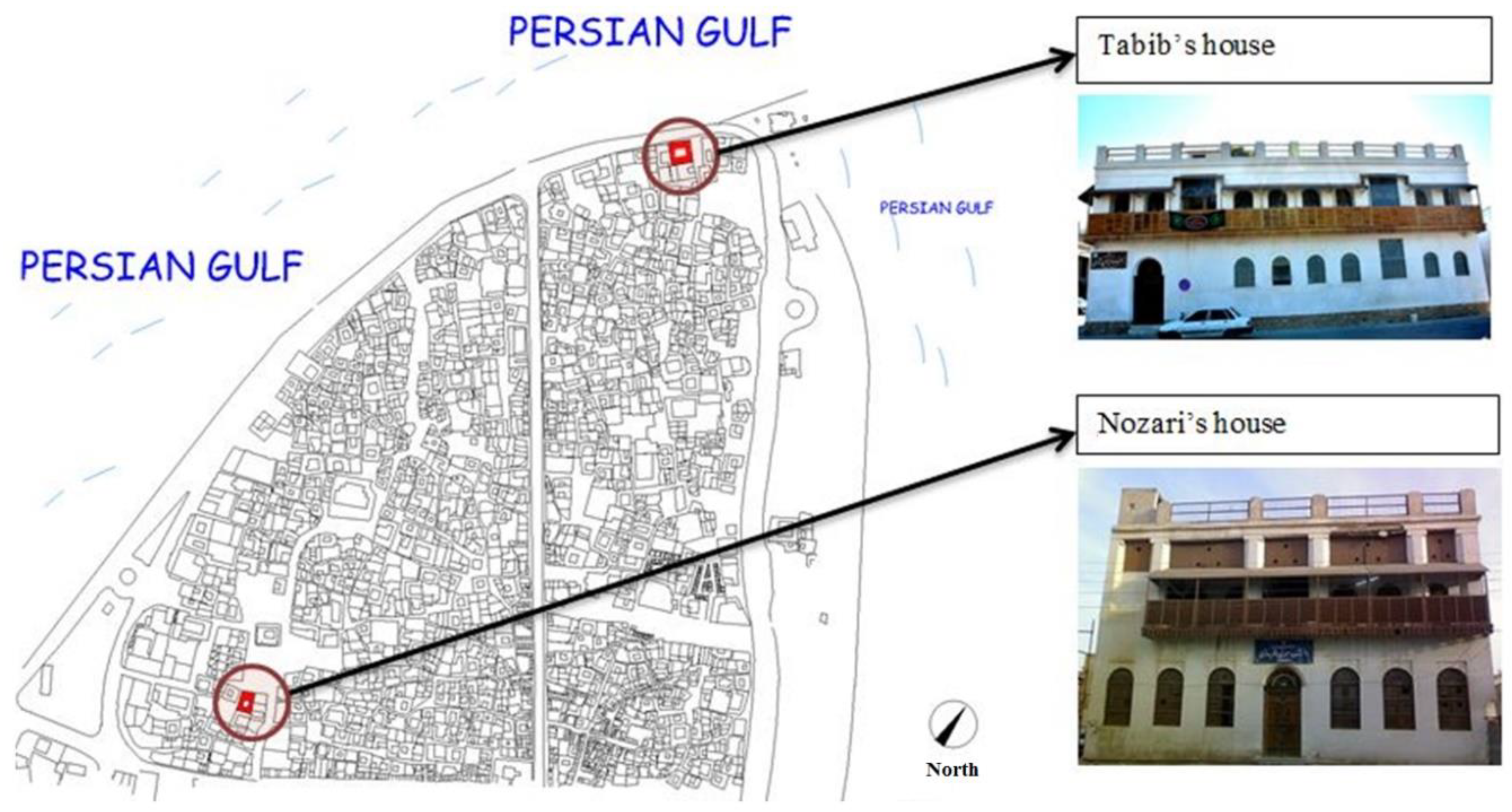

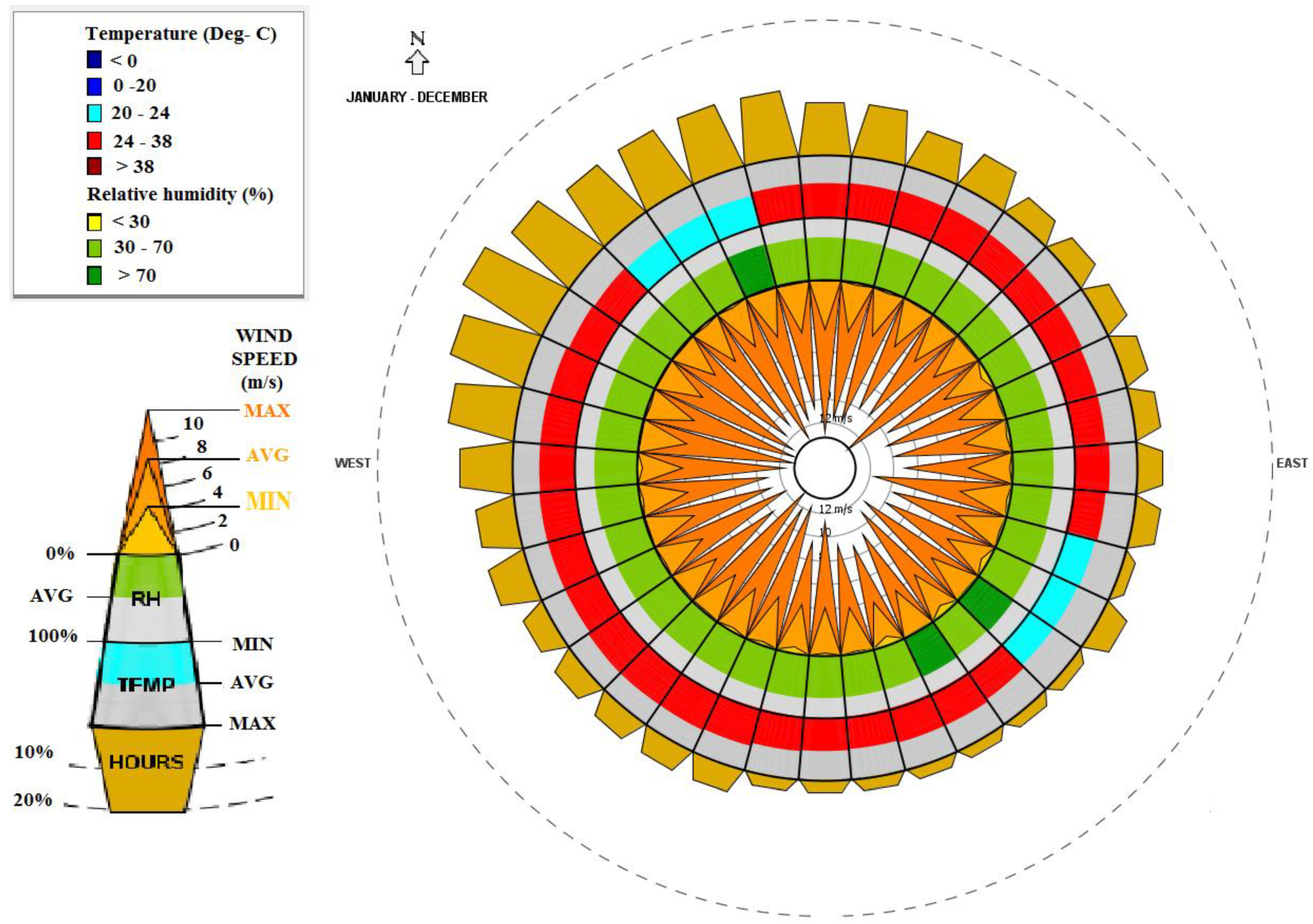
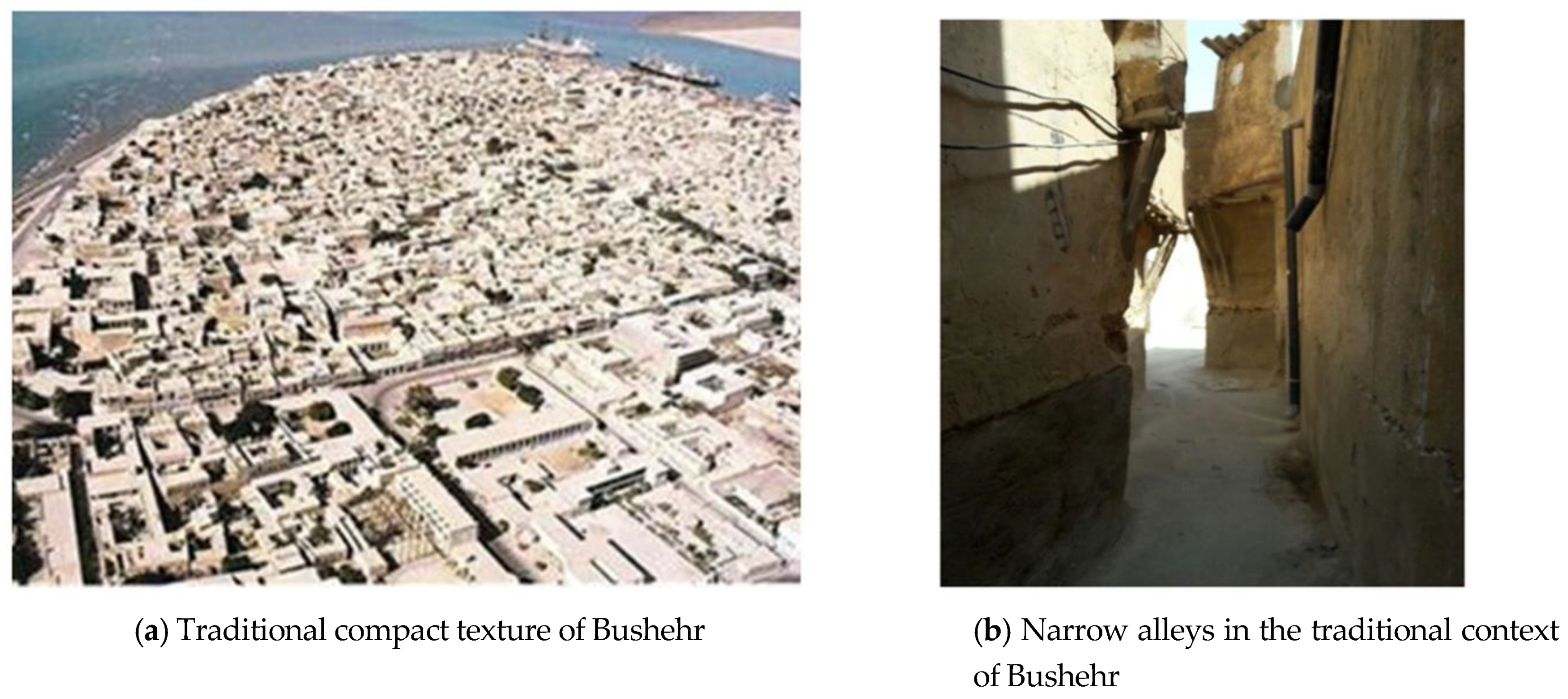

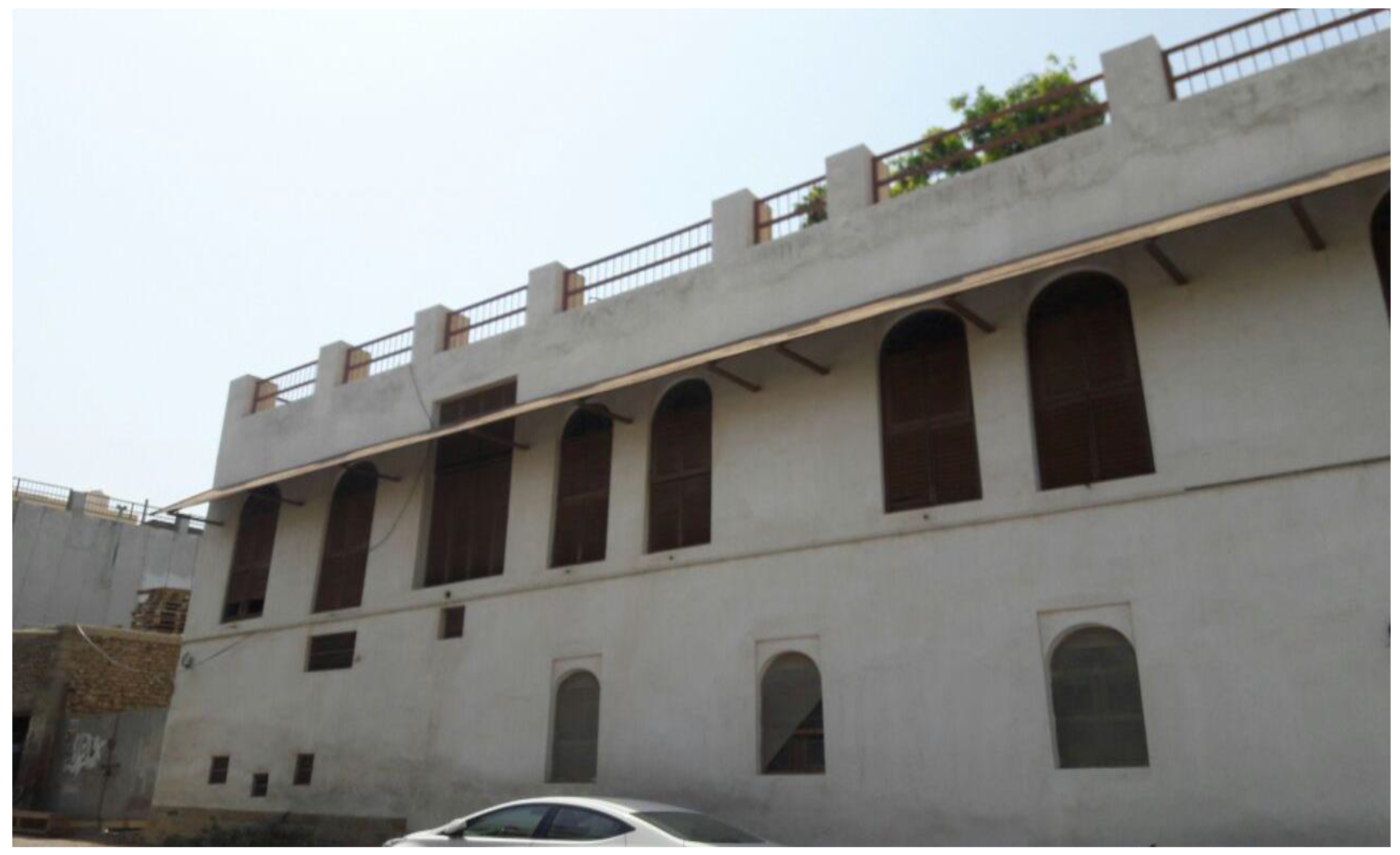

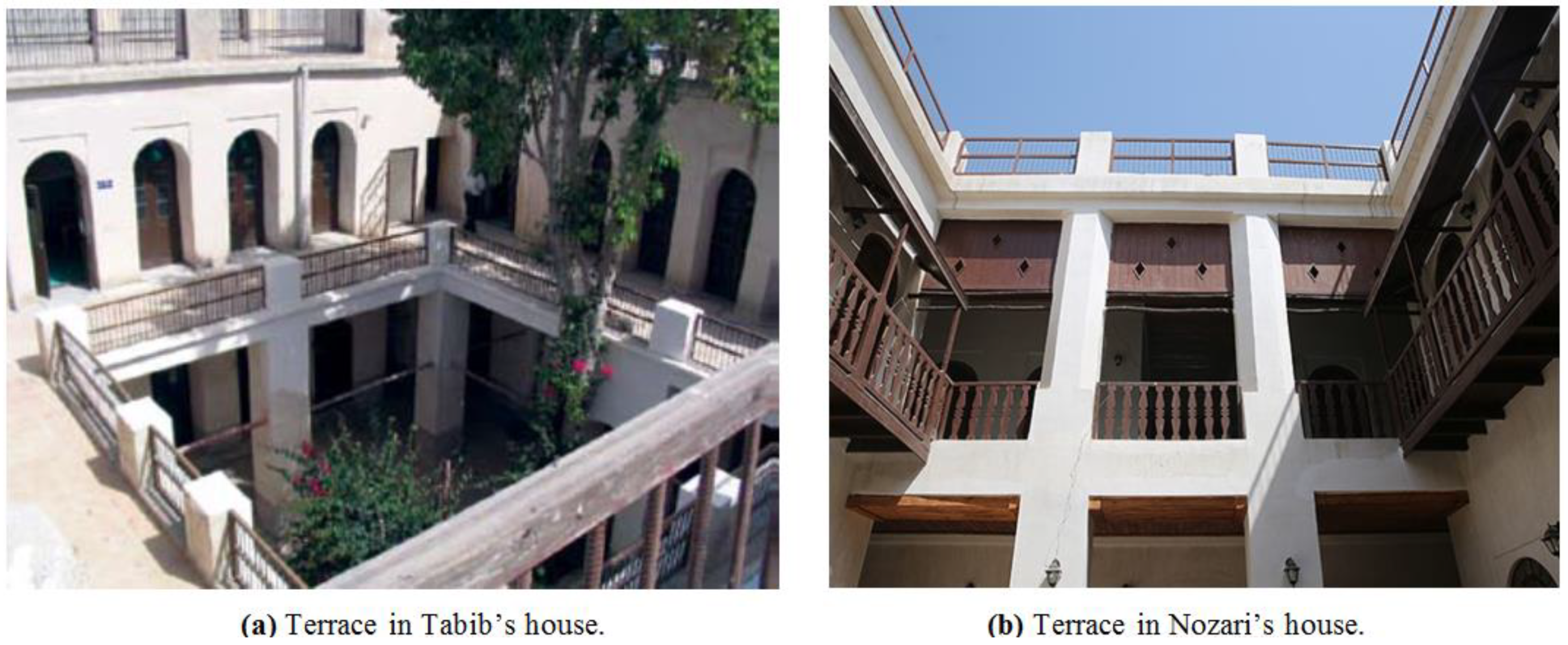
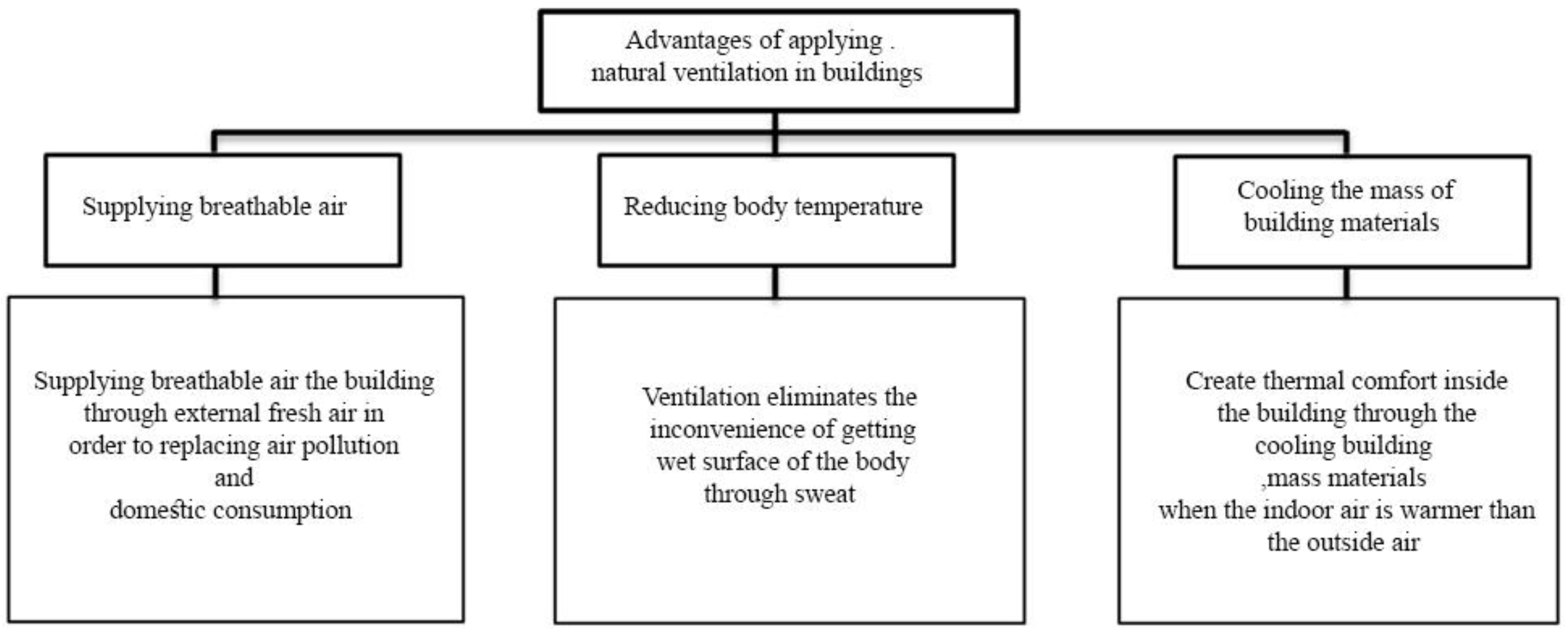

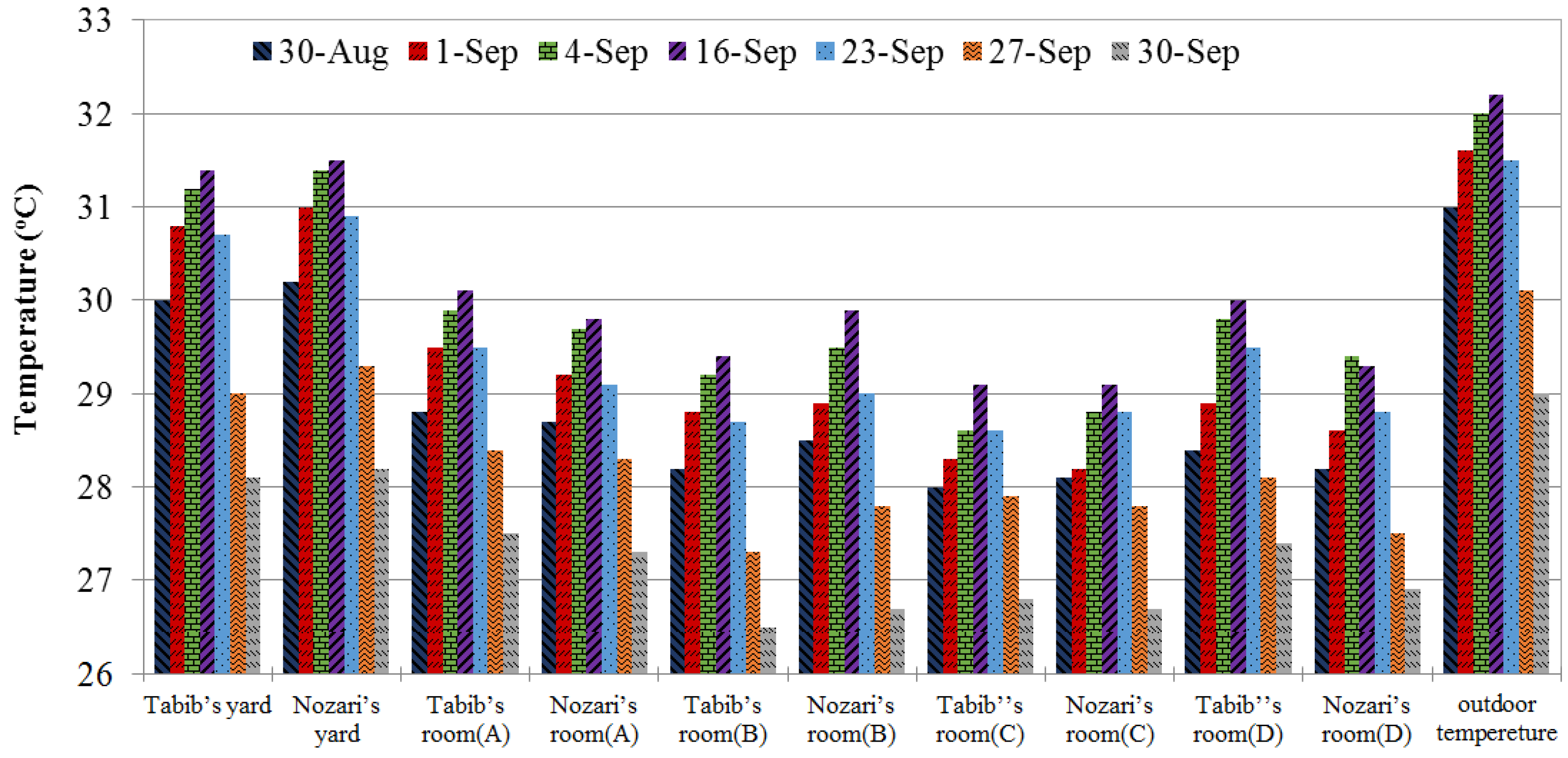
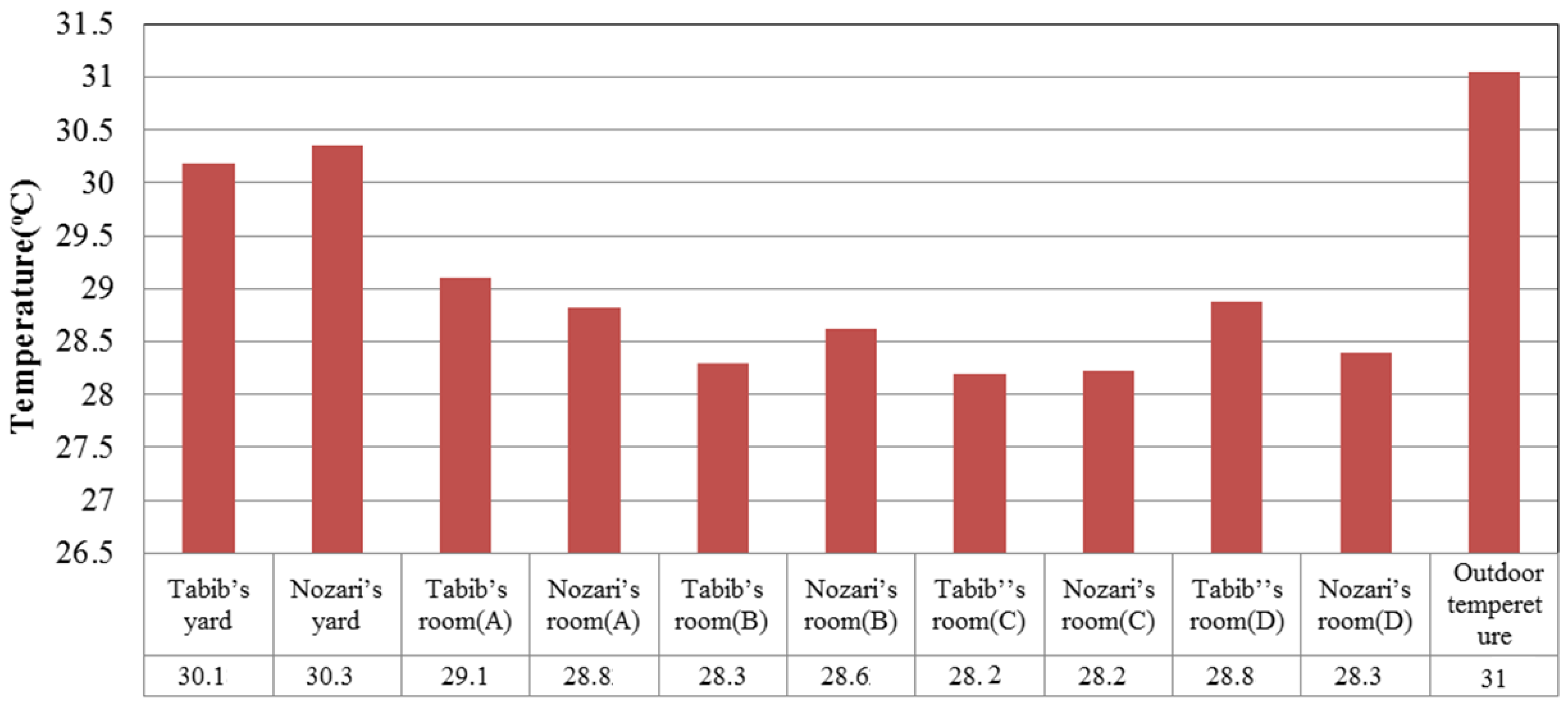

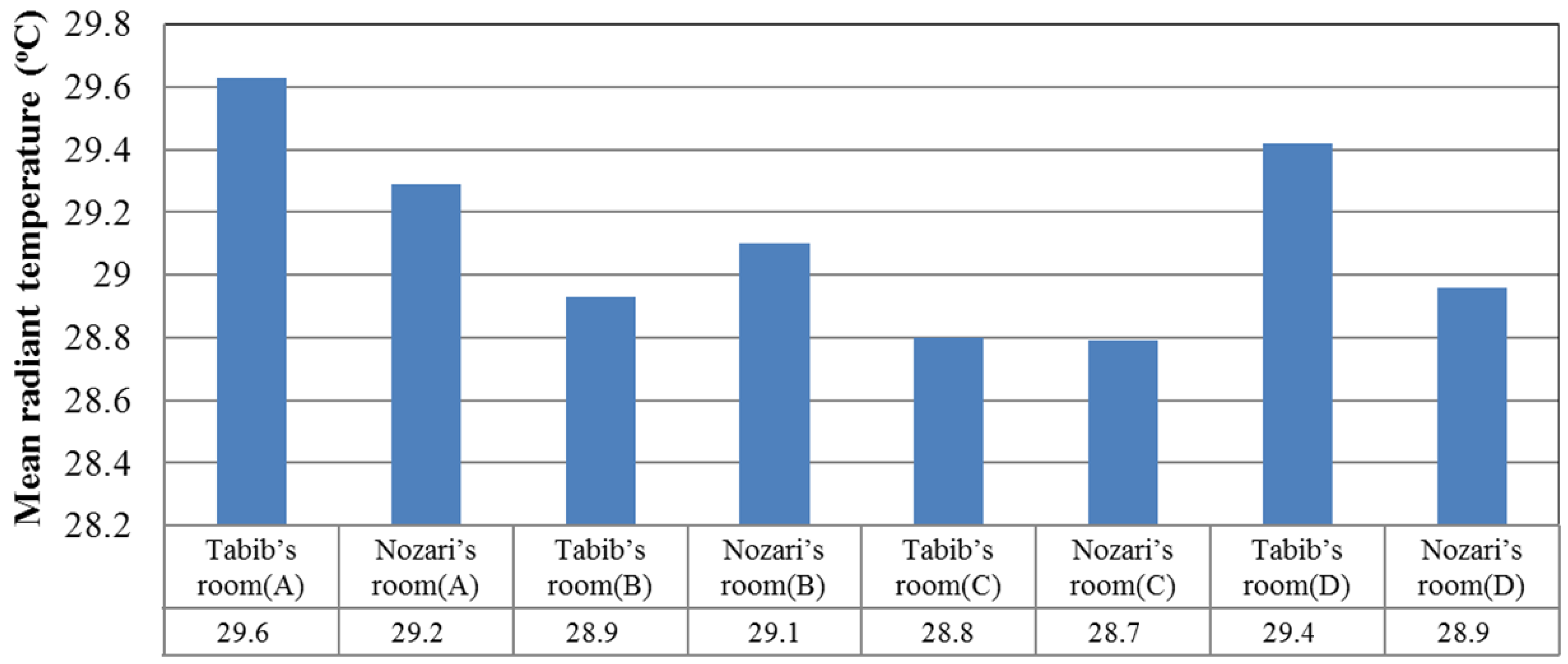
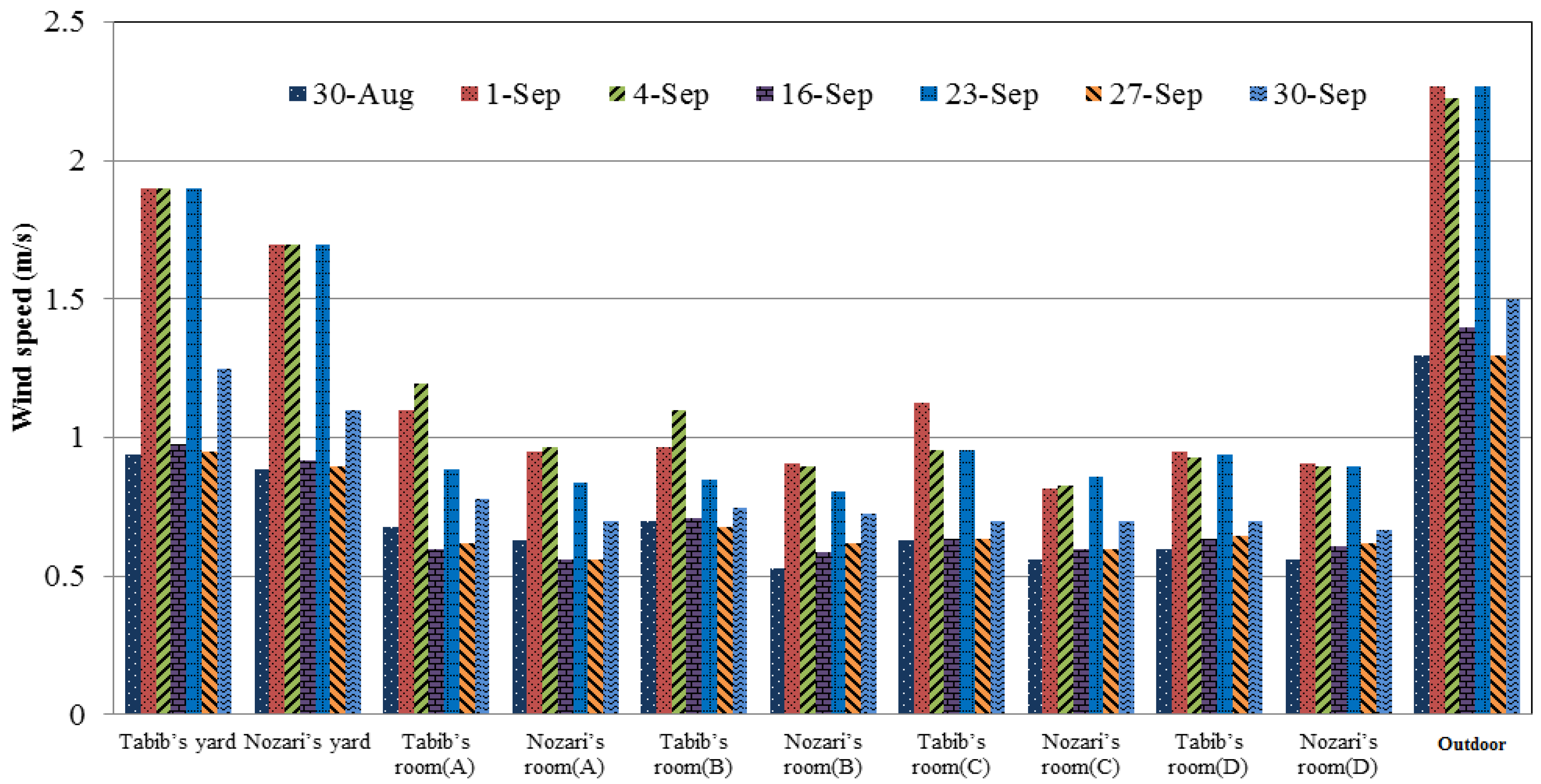
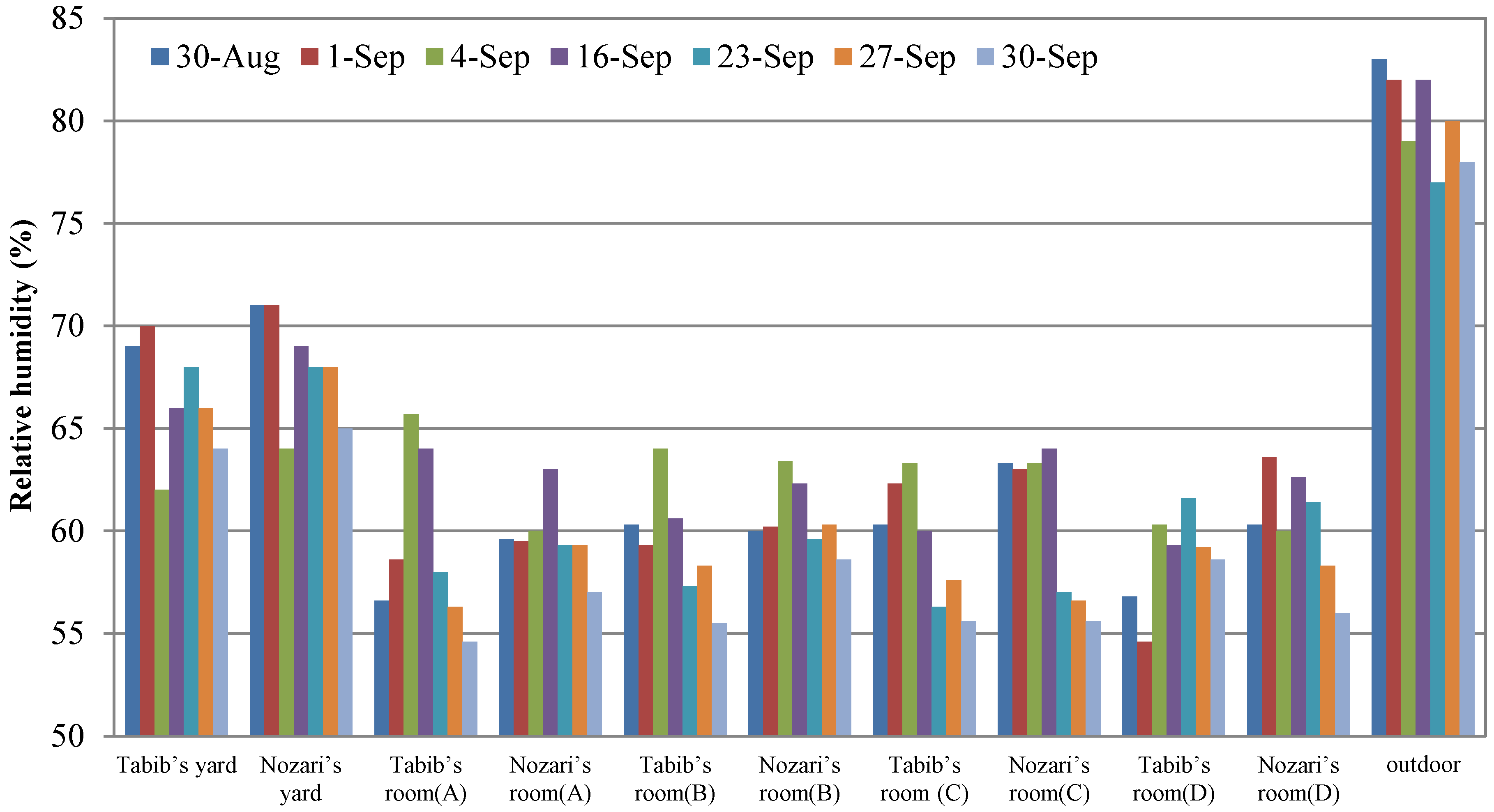

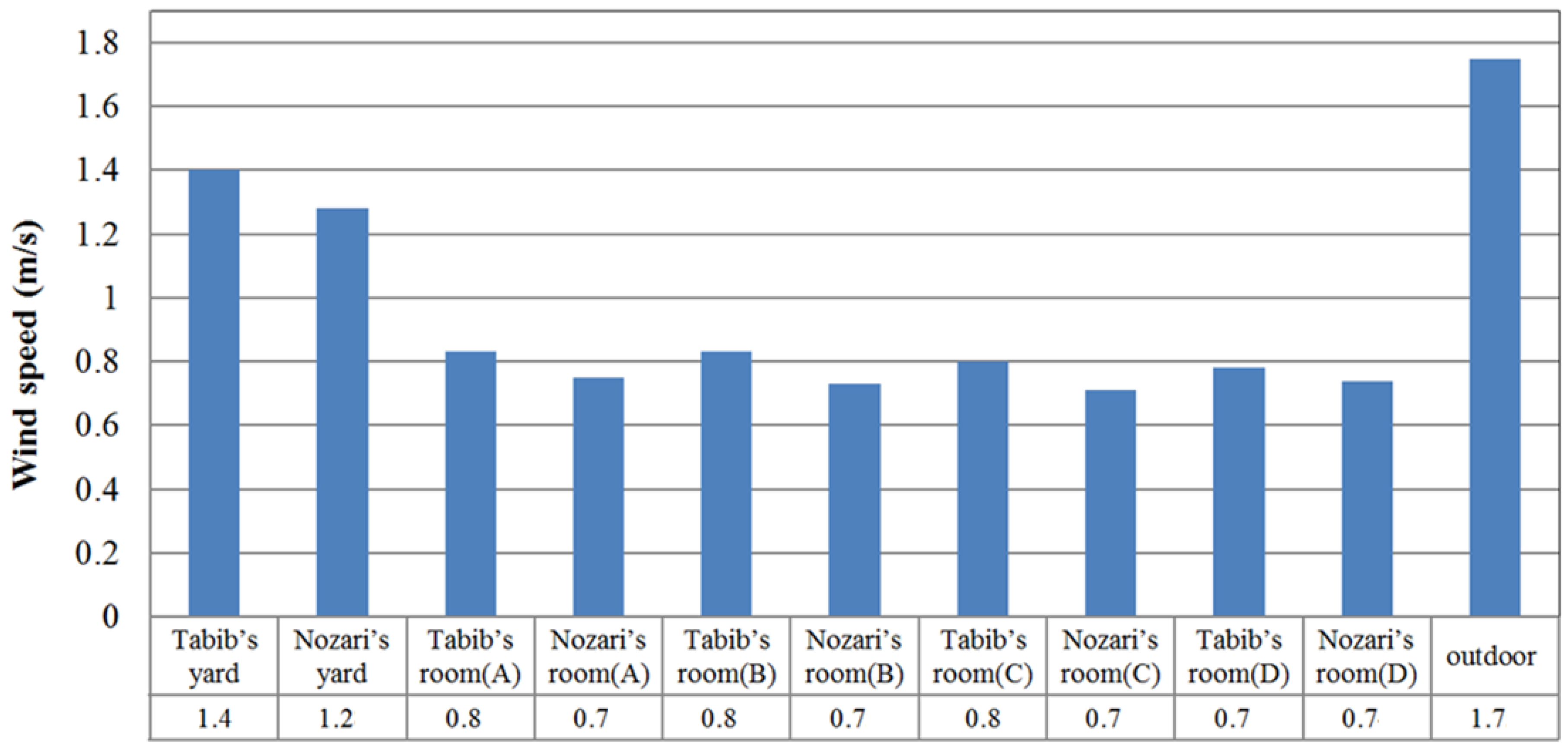



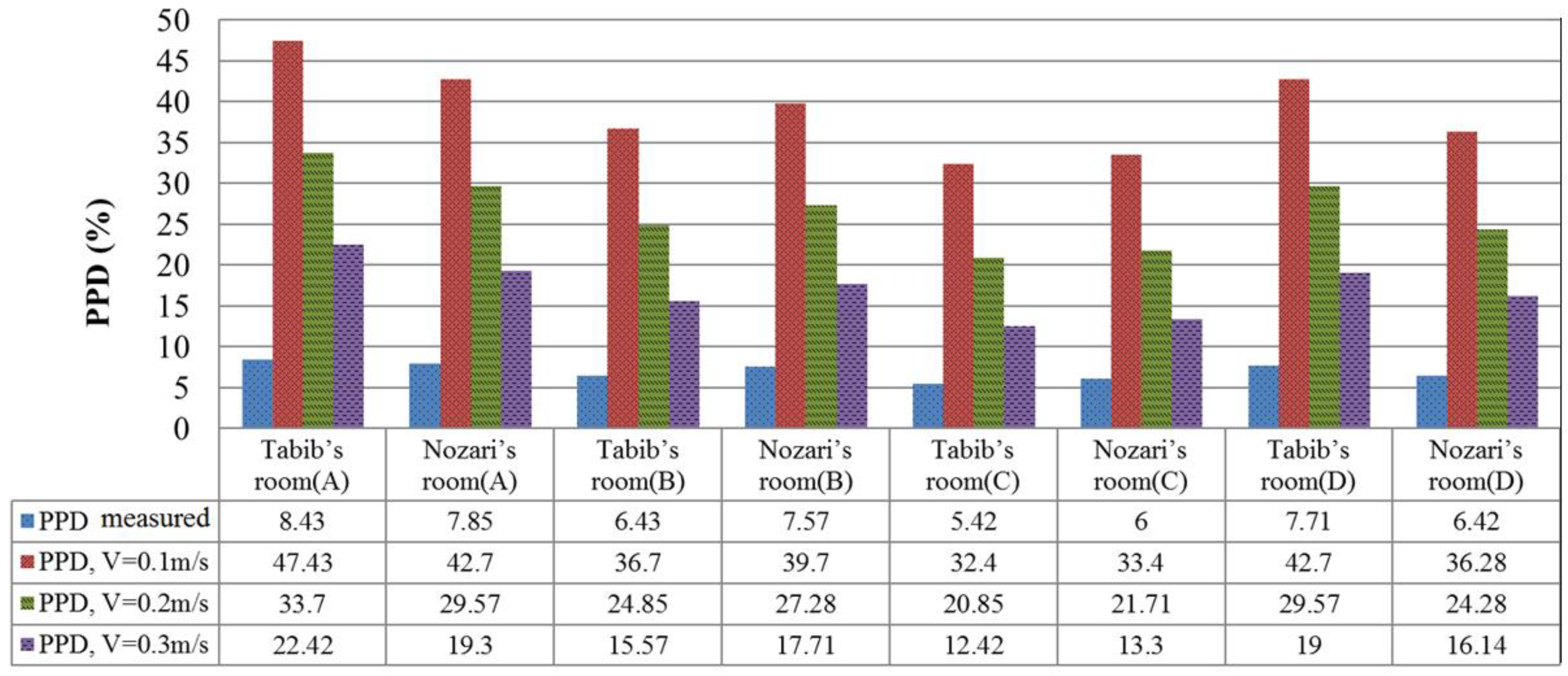
| Month | Average Temperature (°C) | Min Temperature (°C) | Max Temperature (°C) | Average Relative Humidity (%) | Min Relative Humidity (%) | Max Relative Humidity (%) | Average Wind Speed (m/s) | Min Wind Speed (m/s) | Max Wind Speed (m/s) |
|---|---|---|---|---|---|---|---|---|---|
| January | 14.9 | 8 | 22.2 | 74 | 44 | 100 | 4.0 | 0.1 | 12.7 |
| February | 16.5 | 10.6 | 23.9 | 72 | 44 | 100 | 4.5 | 0.1 | 12.8 |
| March | 19.9 | 13 | 29.3 | 69 | 44 | 98 | 4.2 | 0.1 | 11.5 |
| April | 24.2 | 17.4 | 34 | 66 | 43 | 97 | 4.3 | 0.2 | 13.2 |
| May | 29.3 | 22.9 | 36.5 | 59 | 38 | 98 | 4.5 | 0.1 | 12.9 |
| June | 31.0 | 26.7 | 37.8 | 65 | 42 | 92 | 4.1 | 0.2 | 12.9 |
| July | 33.1 | 27.7 | 38.8 | 67 | 42 | 96 | 3.9 | 0.1 | 12.5 |
| August | 33.7 | 28.8 | 38.4 | 72 | 51 | 100 | 3.8 | 0.1 | 11.7 |
| September | 31.3 | 26.2 | 37.5 | 70 | 43 | 100 | 3.5 | 0.1 | 11.7 |
| October | 28.4 | 22 | 35.2 | 68 | 38 | 99 | 3.2 | 0.1 | 11.2 |
| November | 22.0 | 13 | 31.6 | 65 | 36 | 98 | 3.8 | 0.1 | 12.3 |
| December | 17.1 | 9.5 | 26.5 | 75 | 45 | 100 | 3.7 | 0.1 | 10.9 |
| Nozari’s Residence | Tabib’s Residence | |
|---|---|---|
| Ground Floor |  |  |
| First Floor |  |  |
| Section A-A |  |  |
| Section B-B |  |  |
© 2018 by the authors. Licensee MDPI, Basel, Switzerland. This article is an open access article distributed under the terms and conditions of the Creative Commons Attribution (CC BY) license (http://creativecommons.org/licenses/by/4.0/).
Share and Cite
Shaeri, J.; Yaghoubi, M.; Aflaki, A.; Habibi, A. Evaluation of Thermal Comfort in Traditional Houses in a Tropical Climate. Buildings 2018, 8, 126. https://doi.org/10.3390/buildings8090126
Shaeri J, Yaghoubi M, Aflaki A, Habibi A. Evaluation of Thermal Comfort in Traditional Houses in a Tropical Climate. Buildings. 2018; 8(9):126. https://doi.org/10.3390/buildings8090126
Chicago/Turabian StyleShaeri, Jalil, Mahmood Yaghoubi, Ardalan Aflaki, and Amin Habibi. 2018. "Evaluation of Thermal Comfort in Traditional Houses in a Tropical Climate" Buildings 8, no. 9: 126. https://doi.org/10.3390/buildings8090126
APA StyleShaeri, J., Yaghoubi, M., Aflaki, A., & Habibi, A. (2018). Evaluation of Thermal Comfort in Traditional Houses in a Tropical Climate. Buildings, 8(9), 126. https://doi.org/10.3390/buildings8090126





